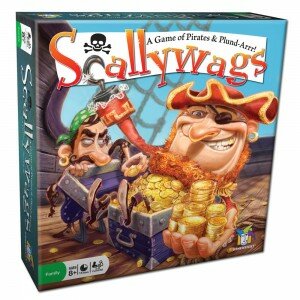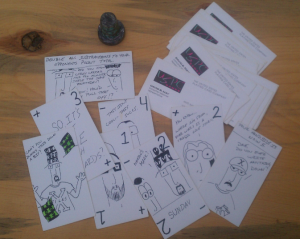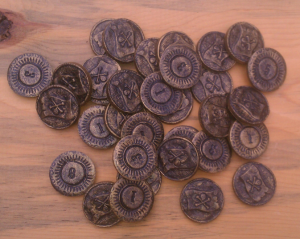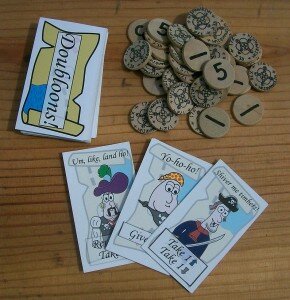
I was delighted when Jay Treat emailed me with a new guest column. If you recall, he wrote an excellent and thorough post on rule writing. One of the purposes of Hyperbole Games is to let good designers showcase good designs. This post does that, exposes some of Jay’s process, and caps off with some great feedback for every designer.
Guest Column by: Jay Treat
I’ve been telling people about Assault on Khyber Station for a while, but I have yet to go into much detail about the game. Of the dozens of games I’ve designed over the years, most fall squarely between unpublishable and trash (even if each had some worthy idea buried beneath the garbage somewhere), which is why I’m so enthusiastic about this one. I’d like to share my baby with you today and discuss one of the hardest decisions I’ve ever had to make as a game designer. It’s the decision that made Assault possible.
Welcome to space. Population 4 and dropping…
Assault is a cooperative game in which players are trying to escape a crumbling space station as it’s overrun by voracious aliens. The board is different every game and is generated by 25 tiles whose placement and orientation determine what paths and rooms are accessible. The setup is entirely random! The space station starts in bad shape as it was just been blasted apart by an attacking alien warship.

It’s up to the players, each with a unique and vital ability, to work together to navigate the wreck, prioritize repairs, avoid deadly aliens, and find the escape teleporter (which has been misplaced). The four roles in the base game are:
- The Mechanic: He can rotate a tile each turn
- The Engineer: He can swap adjacent tiles
- The Marine: He can fight the otherwise-ubiquitously-deadly aliens
- The Smuggler: Her space suit allows her to wander outside the safe corridors of the station to investigate otherwise inaccessible tool chests.
The team needs to access as many of these tool chests as possible to determine the location of the escape teleporter. Reshaping the board is critical to that goal. The ravenous aliens flooding your extrastellar home aren’t the only thing making life difficult. Khyber Station has suffered critical damage and is actively falling apart. Every turn, a new system failure is revealed, throwing wrenches in the best of plans. As frustrating as these system failures are, you’ll miss them when they’re gone, because when the deck runs out, all life support fails and everyone left on board is killed instantly. In a four player game, you only use 7 of the game’s ~60 possible system failure cards.
What makes it special?
Part of the inspiration for the different roles in Assault is the party game Cranium. In the same way that the different Cranium categories play to different players’ strengths, Assault intentionally includes roles with abilities that will appeal to different types of players. The Mechanic and Engineer are for the spatial thinkers, the puzzle players, and the generally clever. The Marine is for the action gamer and hack-and-slash combat enthusiast. The Smuggler is for the finesse player, the end-zone touch-down guy, and the rogue with her own agenda.
Even though each player interacts with the game in a very different way, every player can and usually must interact with the other players. Sometimes the Engineer needs the Marine to clear out an alien-infested corridor so she can swap tiles on the other side. A tool chest in the corner of the map is accessible by the Smuggler, but only if the Mechanic rotates it first. The Engineer and the Mechanic commonly need to work in tandem to form bigger rooms everyone can access. There are more points of interaction than I can list, and that unique interdependence really sells this “Team of Misfits” experience.

The tile system is simple, but it provides a lot of interesting gameplay and was the original impetus for Assault. It is the only significant mechanic of the game I ripped apart to fuel Assault’s genesis (more on that soon). The light corridors are always accessible (if you line them up correctly), but the grey areas (with the grated floors) are off limits until you arrange a group of tiles such that they’re entirely closed on all sides, forming a room (at which point an air-lock will get you in). I’ve been playing with game-worthy maze concepts like this for a long time and I’m excited to finally present one that’s both intuitive and interesting.
In order to find the escape teleporter that makes victory possible, players must open tool chests. There’s one tool chest on every tile, but they’re all arranged such that you cannot reach them from the corridors without first completing the room that contains them. When you open a tool chest, the player obtains a random tool that might give her the edge she needs later in the game. But, more importantly, a deduction card is also drawn that lets you mark off some of the tool chests, which reduces the possible locations you have to check for the teleporter. When you’ve opened or marked every tool chest but one, you’ve found the escape teleporter!
Despite being themed as deduction, this is really induction and it was inspired by the very good island game, Tobago. This solution is critical to keeping every game challenging because you can never randomly stumble upon the goal on the first or second turn.
What came before?
I created Assault on Khyber Station as an entirely new attempt to use the core mechanic and principle of an earlier design that I’d scrapped. Delve was a fantasy-themed dungeon crawler in which players moved through corridors of the dungeon and revealed and placed new tiles as they went. When you placed a tile that finally enclosed a room, you also found the door to it and placed it so that you could enter and find the treasure within.

Like any good co-op dungeon crawler, each player had a different character: Elf, Dwarf, Wizard, and Warrior. I wasn’t trying to blow anyone’s mind here. The game used four different colors of dice and each character specialized in one. It also used a neat hit location / gear mechanic that was fun and relatively innovative. Unfortunately, the game was very long and careful scrutiny showed that the handfuls of dice you rolled and their different effects, while fun, weren’t really worth the mental effort they required. While there were some interesting new mechanics, the game played at a high level like most any other dungeon crawler. I made the difficult decision to stop working on it.
From the Ashes
Not all was lost, because apart from the length, most players enjoyed most of the playtests. I set out to find the core elements that were fun and interesting to create a new game. As is too often the case with games new designers make, the dungeon crawler wasn’t one game so much as an epic amalgamation of several. I’m certain I’ll explore a game featuring lots of dice with different effects again, and a game based off the hit location / gear body chart, but those mechanics weren’t as inspiring as the tiles or the idea of a cooperative game with specialized characters.
Without the dice to differentiate the heroes, how could I make each feel unique? The warrior should be better at fighting, the wizard capable of weird stuff, the elf should be mobile somehow, and the dwarf should be better at opening treasure. Or something. Truth be told, this happened more than a year ago and I’m reconstructing the transition from memory. The haze of time has obscured the order of events, but I know I also wanted to re-theme the game to something less ubiquitous than the universal go-to that is Fantasy. I considered several options, but when I considered Fantasy’s closest cousin, Science Fiction, I think that’s when it occurred to me the board could start with all the tiles already placed and instead of needing to find the doors to rooms, it would be up the players (starting with the wizard) to manipulate the tiles and complete rooms.
Because I wanted to make this cooperative puzzle-esque game with as little mechanical overhead as possible (excess mechanisms being Delve’s primary cause of death), I eliminated damage and hit tracking for the simplest combat system possible: Aliens kill players, with the lone exception that Marines kill Aliens. Take that, math! It also became immediately apparent that players would need to both move and rotate tiles. Relocating tiles without limit was clearly absurd, so swapping adjacent tiles was born. With the Mechanic and Engineer in place, I still needed a mobile Elf, sneaky Rogue or trap-breaking Dwarf. What fun is a game set in space if everyone stays inside the whole time? Adding a spacesuit was perfect for the theme and enabled this fourth character, which actually plays a very important role in the game.
A New Hope
The game in its new form came together quickly. There were important changes after the first few tests, of course, but it showed promise immediately and wrapped interesting gameplay with compelling teamwork and a solid theme. The standard barrage of playtesting suggested numerous tweaks and helped us explore and reject some alternatives. Throughout, it was important to me that the game be hard enough that victory is never certain and that players remain legitimately challenged throughout. I figured out the minimum number of turns a given playgroup needed to beat the game just over half the time and made that the target.
Not all of the alternatives we tested were duds, and several of them led to real ideas that were either integrated into the base game or set aside for some sort of expansion or advanced mode. I’ve been conflicted with how to present these. Does it make more sense to try to sell them as an official expansion or should they be included in the original box? If so, should they be presented as standard parts of the game, or roped off with a sign: “Don’t open until you’re bored with the main game?”
There are four new roles that will appeal to more types of players and offer substantially different game experiences (the Crafter, the Builder, the Security Chief and the Warp Technician), but the addition I most want to talk about is motivations.
Group Solitaire vs the Traitor
One of the most common problems with cooperative games is the group solitaire problem in which one player tells the others what to do so much that he might as well be playing solitaire. A game with no private information between players is particularly prone to this defect and Assault is no exception. I recommend never playing with people like that as a general rule, but games that are only fun if played in the spirit of the game (story-telling games spring to mind), while far from worthless, are certainly less than ideal. Gamers gonna game, and your game can’t break when they do.
I needed to add private information. Cooperative games like Pandemic and The Hobbit depend on each player having a card of hands only they can see to combat the solitaire problem, but necessarily lax communication rules undermine that solution. For me, the better answer was clearly to have some kind of a traitor like Shadows over Camelot. Trouble is, Assault is difficult enough when all the players are working together: there’s no way the good guys could succeed with a player actively sabotaging them, at least not without re-engineering the game from the ground up. This wasn’t an option as I wanted this addition to be entirely optional.

Fortunately, the wording of the actual win condition in the core game inspired a reasonable solution. Every player wins if any player escapes (because that person warns Earth and prevents the aliens from conquering the planet and enslaving or eating your family). What if every player didn’t have a family? What if there was a loner who could only win if he personally escaped? The Loner isn’t so evil that he wouldn’t warn Earth, meaning the parents still win if only the loner escapes. What if there was a hero who insisted on getting two or more other players out first? Because it’s vital that the teamwork core to the game experience never be compromised, there are no motivations that win by preventing other players from escaping. The closest is the Opportunist who, like the Loner, needs to escape to win, but unlike the Loner won’t warn Earth and so his escape doesn’t cause anyone else to win by itself.
It’s still possible for everyone to win, of course, if more than one players escapes in time, but you can no longer assume that any one player is trustworthy enough to assure your victory. Because the motivations are private, you need a little something to help you figure out what motivations other players might have (or else it’s just a crap shoot). Therefore, different roles have different maximum movement rates. Normally, everyone can move up to five spaces each turn, but some motivations allow you to move up to six or limit you to four. Carefully watching how your teammates move each turn can exonerate or cast suspicion on them to help you decide who to trust in those final hair-biting turns.
The Future and Beyyyond
The game’s in good shape*. Publishably good shape, if my years of trying and failing to design a publishable game have taught me anything. I had great success showcasing it at an UnpubMini not too long ago and it pitched well enough to at least be considered by Asmodee and AEG (and ultimately rejected for who-knows-what-reason, hopefully business needs). I’m excited to Kickstart a game, but I wouldn’t Kickstart Assault on Khyber Station as my first project because it involves tiles and miniatures — two things my lack of manufacturing experience could botch pretty badly. Ideally, I’d Kickstart a card game (working on that) and then leverage that success to find an established publisher for Assault.
I’ll be at GenCon this year and will try to talk to more publishers then, but I know from last year how hard it is to get an ear. Most publishers have enough on their plates that they’re just not interested in talking to new designers. Blah blah catch-22, you know the drill.
*I do still think about the game. Until a project is locked in by a deadline of some sort, it’s impossible for an invested creator not to keep tweaking and wondering. The biggest question that remains in my head is if there’s any way to streamline the game even further. The core of the game works without tools and that’s probably reason enough to eject them (or save them for the expansion), but they’re so much fun and it’s amazing when they give a player a clever play to turn around a seemingly hopeless game at the last moment. Ah, the questions designers must ask themselves!
Game Design, Pruning, and Reconstruction
The design tool I want you to walk away with today is an understanding of when you would be better served by destroying one of your creations than continuing to tweak it in its current form. This is a hard question and I can’t give you a single hard-and-fast rule that will answer it for you. Even worse, the information you need to make that decision is worthy of an article all to itself. Until then, I’ll tell you what I can.
What is the core of your game? You need a theme, a mechanic, and a play experience. If you answer that question with more than one answer for these three aspects, you’re almost certainly cramming too much in and should consider jettisoning extraneous parts or breaking the game up into two or more simpler games. For example, “Assault on Khyber Station is a SciFi tile game with interdependent team play.” Simple enough and it says everything I really need to about the game. My answer for Delve is something more like, “it’s a Fantasy tile-laying dungeon-crawler with loot that affects clever dice-based combat and team play.” Even massaging it down, it’s still fairly unwieldy.
I played a sim-city-esque board game recently with a very neat zoning/building/value mechanic and a fun and interactive political simulation where players bid for actions. The two were tied together in a couple ways, but both felt like the heart of their own game and the combination just made a complex whole with less focus and longer games. Not a lot of players are going to love that, but making two separate games would preserve both ideas and generate two games instead of one, each with a stronger identity and tighter gameplay.
So you’ve figured out your game has too much going on. How do you decide whether to trim the fat, split your baby into two, or trash the entire thing? If you’re just trimming, how do you decide what to keep and what to toss? This is where understanding your game’s identity becomes crucial. The marketplace has no room for aimless hybrids. Your quiz/flicking game might be unique, but if those elements aren’t married together so intimately that divorcing them would ruin the whole thing, your innovation is a liability, not a feature.
Some of the mechanics in your game are going to be cleverer than others, some more fun, and some more thematic. Those qualities can guide your decision, but ultimately you have to choose what will be best for this game and that depends on the nature of the game. If you’re making a war game, preserve tactical choice over simplicity; if you’re making a party game, prioritize the wildest moments over team play; if you’re making a real-time game, clarity trumps replayability. For Delve, the tiles trumped the dice and teamwork trumped monsters/treasure/etc, leaving Assault focused on things that make it fun and unique, rather than burdened with the trappings of the original genre.
I can’t find a better abstract explanation or concrete example, so I’ll try one last method: Analogy. You know when you’re building a Magic deck around a card that you’d really like to play with? If you don’t, go play now. Magic is required reading for game designers. You find the cards that best support your pet card, shuffle them up, and start tweaking the deck as you learn how it plays. And maybe half the time as you replace card after card to hone your deck into a lean beast of wizardly destruction, you realize that you need to cut your pet card. The very impetus for the deck no longer does enough to warrant its own inclusion. It hurts to pull it out, but the end result is a better deck that would never have found through another path.
How many of History’s greatest success stories end with the hero finding something far greater than what they’d set out for? Columbus, Pasteur, Gygax; All these and countless more have achieved beyond their wildest dreams by accepting that it is the journey, not the destination. Don’t miss your success just because it wasn’t what you were trying for.












 The best way to make sure your game always plays as expected is to test the extremes. If a player can roll all 1′s in your dice game and is guaranteed to come in last place, that doesn’t just indicate that one in a million games will be an auto-loss, it strongly suggests that many games could be skewed to the point of being unfun. If, on the other hand, there is no combination of luck that can guarantee a loss, perhaps given a particular strategy, then you can be confident that no game in the possible spectrum will be ruined for that reason.
The best way to make sure your game always plays as expected is to test the extremes. If a player can roll all 1′s in your dice game and is guaranteed to come in last place, that doesn’t just indicate that one in a million games will be an auto-loss, it strongly suggests that many games could be skewed to the point of being unfun. If, on the other hand, there is no combination of luck that can guarantee a loss, perhaps given a particular strategy, then you can be confident that no game in the possible spectrum will be ruined for that reason. It’s entirely natural to keep adding cool new things to your game. A is cool, therefore wouldn’t A+B and A+C be even cooler? Whether they are or not, you need to seriously consider whether those additions are needed to make the game fun or if they just add more bulk to the rules and thus length and difficulty to learning the game.
It’s entirely natural to keep adding cool new things to your game. A is cool, therefore wouldn’t A+B and A+C be even cooler? Whether they are or not, you need to seriously consider whether those additions are needed to make the game fun or if they just add more bulk to the rules and thus length and difficulty to learning the game. Sometimes a game knowingly includes a rule that’s impossible for other players to verify for correctness, and sometimes these tricky situations just sneak in. “Draw two cards, then put one back on the top of your deck.” If you put the cards you drew into your hand, your opponent can’t be sure that the card you put back was part of that pair or had already been in your hand. If you’re not paying attention, you may not even be able to tell.
Sometimes a game knowingly includes a rule that’s impossible for other players to verify for correctness, and sometimes these tricky situations just sneak in. “Draw two cards, then put one back on the top of your deck.” If you put the cards you drew into your hand, your opponent can’t be sure that the card you put back was part of that pair or had already been in your hand. If you’re not paying attention, you may not even be able to tell. Ray Mazza is a Creative Director with whom I’ve worked for years at Electronic Arts. Ray has long been a design mentor of mine, primarily because Ray often comes up with the magical experiences you would have never thought of yourself. When I read this column submission from Ray I knew it had to be the first post for Hyperbole Games. It’s bold, a little arrogant, and so absolutely true. Why shouldn’t we create something new? I also love Ray’s examples which are sure to rile some folks. Enjoy!
Ray Mazza is a Creative Director with whom I’ve worked for years at Electronic Arts. Ray has long been a design mentor of mine, primarily because Ray often comes up with the magical experiences you would have never thought of yourself. When I read this column submission from Ray I knew it had to be the first post for Hyperbole Games. It’s bold, a little arrogant, and so absolutely true. Why shouldn’t we create something new? I also love Ray’s examples which are sure to rile some folks. Enjoy!